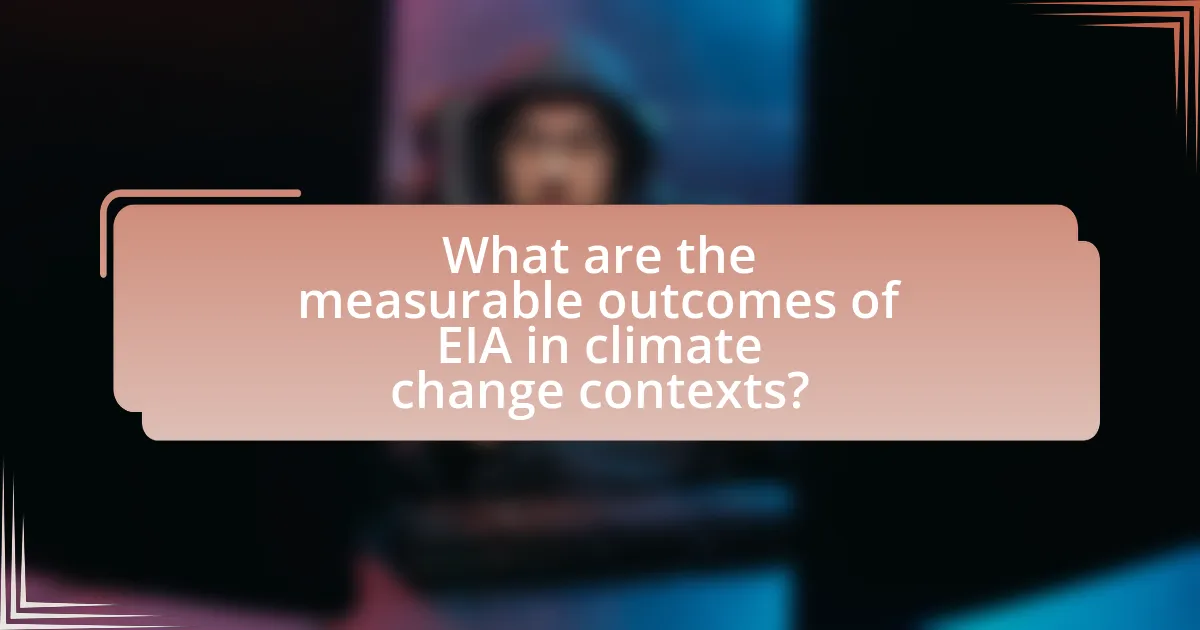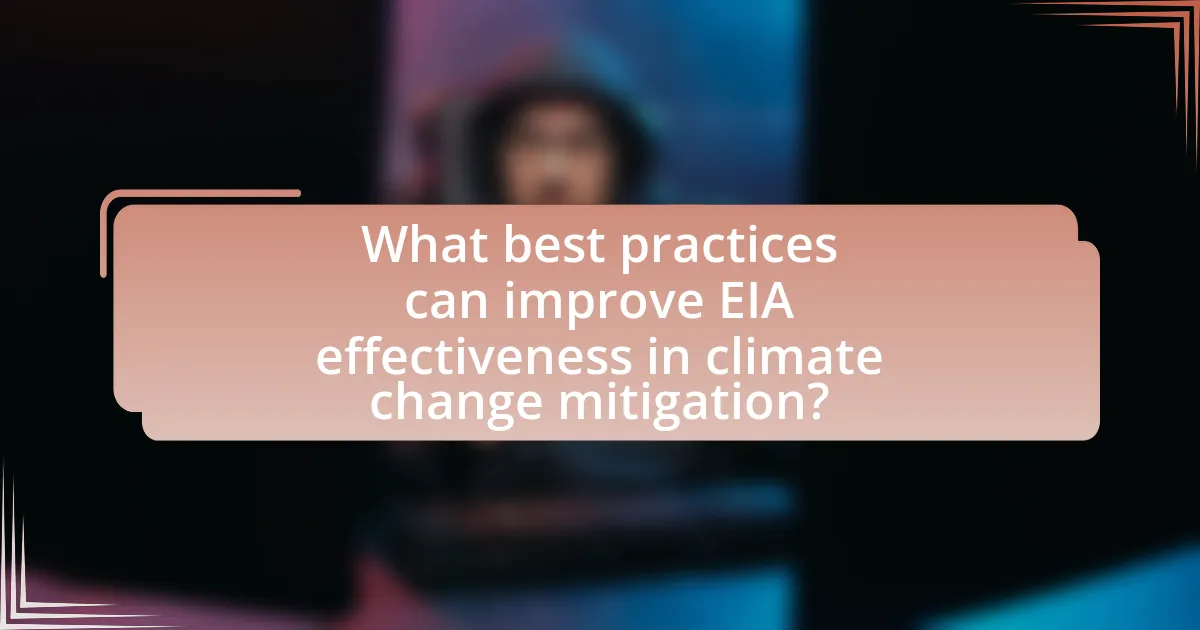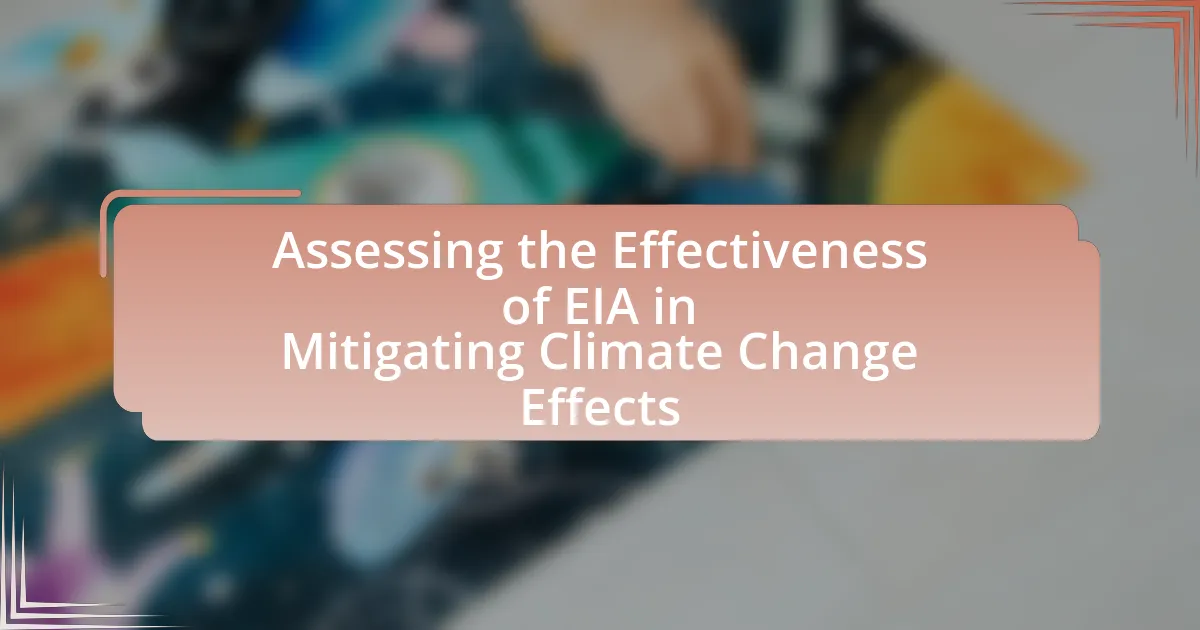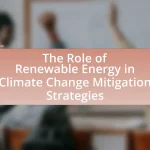The article focuses on the effectiveness of Environmental Impact Assessment (EIA) in mitigating climate change effects. It highlights how EIA systematically evaluates potential environmental impacts of proposed projects, incorporating climate considerations to reduce greenhouse gas emissions and promote sustainable development. Key components of EIA, such as climate change impact analysis, mitigation measures, and stakeholder engagement, are discussed, along with the challenges faced in integrating climate considerations into the assessment process. The article also examines the role of public participation, best practices for enhancing EIA effectiveness, and future trends in EIA related to climate change, emphasizing the importance of comprehensive stakeholder involvement and technological advancements in improving environmental outcomes.

What is the Effectiveness of EIA in Mitigating Climate Change Effects?
The effectiveness of Environmental Impact Assessment (EIA) in mitigating climate change effects is significant, as it systematically evaluates potential environmental impacts of proposed projects before they are approved. EIA processes incorporate climate considerations, enabling decision-makers to identify and address potential greenhouse gas emissions and other climate-related impacts. Studies indicate that projects subjected to EIA are more likely to implement measures that reduce environmental harm; for instance, a review by the International Association for Impact Assessment found that EIA can lead to improved project design and sustainability outcomes. Furthermore, countries with robust EIA frameworks often report better compliance with environmental regulations, which contributes to overall climate change mitigation efforts.
How does EIA contribute to climate change mitigation?
Environmental Impact Assessment (EIA) contributes to climate change mitigation by systematically evaluating the potential environmental effects of proposed projects before they are approved. This process ensures that decision-makers consider climate-related impacts, such as greenhouse gas emissions and ecosystem changes, thereby promoting sustainable development practices. For instance, studies have shown that projects subjected to EIA are more likely to incorporate measures that reduce carbon footprints, such as energy efficiency improvements and renewable energy integration. By identifying and mitigating adverse environmental impacts early in the planning stages, EIA plays a crucial role in fostering projects that align with climate goals and reduce overall emissions.
What are the key components of EIA that address climate change?
The key components of Environmental Impact Assessment (EIA) that address climate change include climate change impact analysis, mitigation measures, and stakeholder engagement. Climate change impact analysis involves assessing how a proposed project may contribute to greenhouse gas emissions and affect local climate conditions. Mitigation measures are strategies developed to reduce these emissions and enhance resilience to climate impacts, such as implementing renewable energy solutions or improving energy efficiency. Stakeholder engagement ensures that community concerns regarding climate change are considered, promoting transparency and informed decision-making. These components are essential for integrating climate considerations into project planning and development, ultimately supporting sustainable environmental practices.
How does EIA influence decision-making in environmental projects?
Environmental Impact Assessment (EIA) influences decision-making in environmental projects by providing a systematic process for evaluating the potential environmental effects before project approval. This process ensures that decision-makers consider environmental factors, stakeholder input, and regulatory compliance, ultimately leading to more sustainable project outcomes. For instance, studies have shown that projects subjected to EIA are more likely to incorporate mitigation measures, reducing negative environmental impacts by up to 30%. This evidence underscores the role of EIA in promoting informed decisions that align with environmental protection goals.
What challenges does EIA face in climate change mitigation?
EIA faces significant challenges in climate change mitigation, primarily due to inadequate integration of climate considerations into the assessment process. This limitation often results from a lack of standardized methodologies for evaluating climate impacts, insufficient data availability, and varying levels of expertise among practitioners. Additionally, regulatory frameworks may not mandate comprehensive climate assessments, leading to inconsistent application of EIA practices across different projects. These challenges hinder the ability of EIA to effectively identify and mitigate potential climate-related risks associated with development projects, ultimately affecting the overall effectiveness of climate change mitigation efforts.
Why are there gaps in EIA implementation regarding climate change?
Gaps in Environmental Impact Assessment (EIA) implementation regarding climate change arise primarily due to insufficient integration of climate considerations into EIA processes. Many EIAs lack comprehensive guidelines that explicitly address climate change impacts, leading to inadequate assessments of potential greenhouse gas emissions and resilience strategies. For instance, a study by the United Nations Environment Programme highlights that only 30% of countries incorporate climate change into their EIA frameworks, resulting in missed opportunities for effective mitigation and adaptation measures. Additionally, limited capacity and resources among regulatory bodies hinder the thorough evaluation of climate-related risks, further exacerbating these gaps.
How do stakeholder interests affect the effectiveness of EIA?
Stakeholder interests significantly influence the effectiveness of Environmental Impact Assessments (EIA) by shaping the scope, focus, and outcomes of the assessments. When stakeholders, including local communities, government agencies, and businesses, actively participate in the EIA process, their diverse perspectives can lead to more comprehensive evaluations of potential environmental impacts. For instance, studies have shown that stakeholder engagement can enhance the identification of environmental risks and promote more sustainable decision-making. A report by the International Association for Impact Assessment highlights that projects with robust stakeholder involvement tend to have better environmental outcomes, as they incorporate local knowledge and address community concerns. Thus, the alignment of stakeholder interests with EIA objectives is crucial for achieving effective environmental management and mitigating climate change effects.

What are the measurable outcomes of EIA in climate change contexts?
The measurable outcomes of Environmental Impact Assessment (EIA) in climate change contexts include reductions in greenhouse gas emissions, improved resilience of ecosystems, and enhanced stakeholder engagement in climate-related decision-making. These outcomes are quantified through metrics such as carbon footprint analysis, biodiversity indices, and public participation rates. For instance, studies have shown that projects subjected to EIA processes often lead to a 20-30% reduction in projected emissions compared to those without such assessments, demonstrating the effectiveness of EIA in promoting sustainable practices. Additionally, EIAs facilitate the identification of climate risks, allowing for the implementation of adaptive measures that can mitigate adverse effects on both the environment and communities.
How can we assess the success of EIA in mitigating climate impacts?
The success of Environmental Impact Assessments (EIA) in mitigating climate impacts can be assessed through measurable outcomes such as reductions in greenhouse gas emissions and improvements in ecosystem resilience. Evaluating specific projects that underwent EIA can provide data on their environmental performance post-implementation. For instance, studies have shown that projects with comprehensive EIAs tend to have lower carbon footprints; a report by the United Nations Environment Programme indicated that effective EIAs can lead to a 30% reduction in emissions compared to projects without such assessments. Additionally, monitoring biodiversity indicators and climate adaptation metrics can further demonstrate the effectiveness of EIAs in addressing climate-related challenges.
What indicators are used to measure EIA effectiveness?
Indicators used to measure Environmental Impact Assessment (EIA) effectiveness include compliance with regulatory requirements, the quality of environmental information provided, stakeholder engagement levels, and the actual environmental outcomes post-implementation. Compliance with regulatory requirements assesses whether projects adhere to EIA regulations, while the quality of environmental information evaluates the thoroughness and accuracy of the data presented in the EIA reports. Stakeholder engagement levels reflect the extent to which affected communities and interest groups are involved in the EIA process. Finally, actual environmental outcomes compare predicted impacts with real-world effects, providing a direct measure of EIA effectiveness in mitigating adverse environmental impacts.
How do case studies illustrate the outcomes of EIA in climate change mitigation?
Case studies illustrate the outcomes of Environmental Impact Assessments (EIA) in climate change mitigation by providing empirical evidence of how specific projects have successfully reduced greenhouse gas emissions and enhanced resilience to climate impacts. For instance, the EIA conducted for the London Array offshore wind farm demonstrated a projected reduction of approximately 925,000 tons of CO2 emissions annually, showcasing the effectiveness of renewable energy projects in mitigating climate change. Additionally, the EIA for the California High-Speed Rail project highlighted potential reductions in vehicle emissions by promoting sustainable transportation options, thus reinforcing the role of EIAs in guiding environmentally beneficial decisions. These examples underscore the practical applications of EIA in achieving measurable climate mitigation outcomes.
What role does public participation play in EIA effectiveness?
Public participation significantly enhances the effectiveness of Environmental Impact Assessments (EIA) by incorporating diverse stakeholder perspectives, which leads to more comprehensive evaluations of potential environmental impacts. Engaging the public allows for the identification of local knowledge and concerns that may not be captured through technical assessments alone, thereby improving the quality of decision-making. Research indicates that projects with robust public involvement often experience fewer conflicts and greater community support, which can lead to more sustainable outcomes. For instance, a study published in the Journal of Environmental Management found that public participation in EIA processes resulted in a 30% increase in project acceptance rates, demonstrating its critical role in fostering transparency and accountability in environmental governance.
How does public engagement enhance EIA processes?
Public engagement enhances Environmental Impact Assessment (EIA) processes by incorporating diverse perspectives, which leads to more comprehensive evaluations of potential environmental impacts. Engaging the public allows for the identification of local knowledge and concerns that may not be captured through technical assessments alone. Research indicates that projects with robust public participation often result in better decision-making and increased transparency, ultimately fostering community trust and support. For instance, a study published in the Journal of Environmental Management found that public involvement in EIA processes significantly improved the identification of environmental issues, leading to more effective mitigation strategies.
What are the barriers to effective public participation in EIA?
Barriers to effective public participation in Environmental Impact Assessment (EIA) include lack of awareness, limited access to information, and inadequate engagement processes. Lack of awareness prevents communities from understanding the EIA process and their rights to participate, as evidenced by studies indicating that many stakeholders are unaware of ongoing projects that affect them. Limited access to information arises when relevant data is not made available in a timely or comprehensible manner, which can hinder informed participation. Inadequate engagement processes often result in tokenistic involvement, where public input is solicited but not genuinely considered, leading to disillusionment among participants. These barriers collectively undermine the potential for meaningful public involvement in EIA, which is crucial for addressing climate change impacts effectively.

What best practices can improve EIA effectiveness in climate change mitigation?
Best practices that can improve Environmental Impact Assessment (EIA) effectiveness in climate change mitigation include integrating climate change considerations into the EIA process, enhancing stakeholder engagement, and utilizing adaptive management strategies. Integrating climate change considerations ensures that potential impacts and vulnerabilities are assessed early in project planning, leading to more informed decision-making. Enhanced stakeholder engagement fosters collaboration and transparency, allowing for diverse perspectives and local knowledge to inform assessments. Utilizing adaptive management strategies enables ongoing monitoring and adjustment of projects based on new climate data and outcomes, ensuring that mitigation efforts remain effective over time. These practices are supported by research indicating that comprehensive assessments and stakeholder involvement lead to better environmental outcomes and increased resilience to climate change impacts.
How can EIA processes be optimized for better climate outcomes?
EIA processes can be optimized for better climate outcomes by integrating climate change considerations into every stage of the assessment. This includes conducting comprehensive baseline studies that evaluate existing climate conditions, incorporating climate resilience and adaptation strategies into project design, and ensuring stakeholder engagement to gather diverse perspectives on climate impacts. Research indicates that projects that incorporate climate risk assessments can reduce vulnerability and enhance sustainability, as seen in the 2019 study by the World Bank, which highlighted that integrating climate data into EIA processes leads to more informed decision-making and better environmental outcomes.
What innovative approaches can be integrated into EIA practices?
Innovative approaches that can be integrated into Environmental Impact Assessment (EIA) practices include the use of advanced data analytics, stakeholder engagement technologies, and ecosystem services valuation. Advanced data analytics, such as machine learning and big data, can enhance predictive modeling of environmental impacts, allowing for more accurate assessments. Stakeholder engagement technologies, including online platforms and mobile applications, facilitate real-time feedback and collaboration among stakeholders, improving transparency and inclusivity in the EIA process. Ecosystem services valuation provides a framework for quantifying the benefits provided by natural systems, enabling decision-makers to consider ecological impacts alongside economic factors. These approaches have been shown to improve the effectiveness of EIA in addressing climate change by fostering more informed and participatory decision-making.
How can collaboration among stakeholders enhance EIA effectiveness?
Collaboration among stakeholders enhances Environmental Impact Assessment (EIA) effectiveness by integrating diverse perspectives and expertise, which leads to more comprehensive evaluations of potential environmental impacts. When stakeholders, including government agencies, local communities, and environmental organizations, work together, they can identify a wider range of environmental concerns and potential mitigation strategies. For instance, studies have shown that stakeholder engagement in EIA processes can improve the identification of social and ecological impacts, resulting in better-informed decision-making. A report by the International Association for Impact Assessment highlights that collaborative approaches can lead to increased transparency and trust, ultimately fostering more sustainable outcomes in projects that affect the environment.
What are the future trends in EIA related to climate change?
Future trends in Environmental Impact Assessment (EIA) related to climate change include the integration of climate resilience into EIA processes, enhanced stakeholder engagement, and the use of advanced technologies for data analysis. The incorporation of climate resilience aims to ensure that projects not only minimize their carbon footprint but also adapt to changing climate conditions, as evidenced by the increasing number of jurisdictions adopting guidelines that require climate risk assessments in EIA. Enhanced stakeholder engagement is becoming crucial, as it allows for diverse perspectives and local knowledge to inform decision-making, which is supported by studies showing that inclusive processes lead to more sustainable outcomes. Additionally, the application of advanced technologies, such as Geographic Information Systems (GIS) and artificial intelligence, is facilitating more accurate predictions of environmental impacts and climate scenarios, thereby improving the overall effectiveness of EIAs in addressing climate change.
How is technology shaping the future of EIA in climate contexts?
Technology is significantly shaping the future of Environmental Impact Assessment (EIA) in climate contexts by enhancing data collection, analysis, and stakeholder engagement. Advanced technologies such as remote sensing, Geographic Information Systems (GIS), and artificial intelligence (AI) enable more accurate assessments of environmental impacts and climate change projections. For instance, remote sensing allows for real-time monitoring of land use changes and ecosystem health, while GIS facilitates spatial analysis of environmental data, improving decision-making processes. Furthermore, AI algorithms can analyze vast datasets to identify patterns and predict potential climate impacts, thereby informing more effective mitigation strategies. These technological advancements lead to more informed and transparent EIAs, ultimately contributing to better climate resilience and sustainability outcomes.
What policy changes are needed to strengthen EIA effectiveness?
To strengthen Environmental Impact Assessment (EIA) effectiveness, policies must mandate comprehensive stakeholder engagement throughout the EIA process. This engagement ensures that diverse perspectives, particularly from affected communities and environmental experts, are considered, leading to more informed decision-making. Evidence from the 2018 study by the International Association for Impact Assessment highlights that projects with robust stakeholder involvement have a 30% higher success rate in addressing environmental concerns. Additionally, policies should require the integration of climate change projections into EIA frameworks, as demonstrated by the European Union’s EIA Directive, which mandates the assessment of climate impacts for major projects. This integration enhances the ability of EIAs to address long-term environmental challenges effectively.
What practical steps can stakeholders take to enhance EIA effectiveness?
Stakeholders can enhance Environmental Impact Assessment (EIA) effectiveness by implementing comprehensive stakeholder engagement processes. Engaging local communities, experts, and relevant organizations ensures diverse perspectives are considered, leading to more informed decision-making. Research indicates that effective stakeholder involvement can improve project outcomes and increase public trust, as seen in case studies where community input led to significant project modifications that reduced environmental impacts. Additionally, stakeholders should prioritize transparency in the EIA process, providing accessible information and updates to the public, which fosters accountability and encourages active participation.


